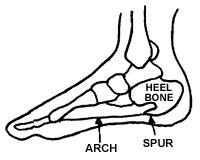Heel Spur Syndrome
A very common reason for patients to seek a podiatrist’s help is due to the pain of a heel spur. Those afflicted are generally active, overweight, and posses an unstable foot type, either high arched, or flat. Athletes have a higher incidence of heel spurs than the overall population.
The intensity of pain varies with the shape and location of the spur, size is not a crucial factor. Most heel spurs are painless at first and may only be discovered while the foot is being x-rayed due to another problem. The spur may later go on to become symptomatic and cause pain and disability.
A heel spur is a bony overgrowth just in front of the heel bone extending along its entire width. Initially the patient has discomfort upon taking the first steps of the day in the morning or standing on their feet after sitting for a prolonged time. Once walking for a few minutes, the arch starts to stretch out and the heel pain decreases to some degree but tends to get worse again at the end of the day. Pain also returns after beginning to walk after periods of non ambulating. Upon examination, there is a localized area of pain under the inner aspect of the heel.
The major cause of heel spurs is abnormal pronation due to an unstable foot type. There is a strong ligament called the plantar fascia, which attached to the front of the heel and stretches along the sole of the foot to the front of the metatarsals. With pronation this ligament is stressed and over a long period of time, reactive changes cause the bone spur.
Treatment can usually be successful without the need for surgical intervention. In the initial treatment, taping of the foot to provide biomechanical control to reduce abnormal pronation, local injection therapy, and anti inflammatory medications are employed. Usually, four or five weekly treatments eliminate the painful complaints while normal routine is uninterrupted. Orthotics are then custom fabricated to control pronation and reduce fascial strain. Over ninety percent of all heel spurs are controlled in this manner. In the remainder of the cases the painful spur must be surgically removed and the tension on the plantar fascia must be released. The patient wears a special shoe for a few weeks, then gradually goes back to regular shoes.
The heel spur syndrome is a common foot ailment which usually responds to conservative medical and biomechanical care and does not have to be a source of discomfort and disability to the patient.
This information has been prepared by the Consumer Education Committee of the American College of Foot and Ankle Surgeons, a professional society of 5,700 podiatric foot and ankle surgeons. Members of the College are Doctors of Podiatric Medicine who have received additional training through surgical residency programs. The mission of the College is to promote superior care of foot and ankle surgical patients through education, research and the promotion of the highest professional standards. Copyright © 2004, American College of Foot and Ankle Surgeons, www.acfas.org





Add a comment